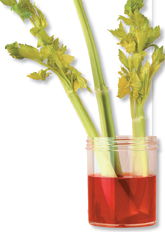Quick Lab
GUIDED INQUIRY
What Is the Role of Leaves in Transpiration?

Use a scalpel to cut 1 cm off the bottoms of three celery stalks. CAUTION: Use the scalpel with care.
Remove the leaves from one stalk. Use a cotton swab to apply petroleum jelly to both sides of all the leaves on another stalk. Place all three stalks into a plastic container holding about 200 mL of water and several drops of food coloring.
Place the plastic container in a sunny location. Observe the celery at the end of the class and the next day. Record your observations each day.
Observe In which stalk did the colored water rise the most? The least?
Infer What effect did the petroleum jelly have on transpiration? What part of the leaf did the petroleum jelly affect?
Draw Conclusions How are leaves involved in transpiration?
Analyze and Conclude

How Cell Walls Pull Water Upward To pull water upward, plants take advantage of some of water's most interesting physical properties. Water molecules are attracted to one another by a force called cohesion. Recall from Chapter 2 that cohesion is the attraction of molecules of the same substance to each other. Water cohesion is especially strong because of the tendency of water molecules to form hydrogen bonds with each other. Water molecules can also form hydrogen bonds with other substances. This results from a force called adhesion, which is attraction between unlike molecules.
If you were to place empty glass tubes of various diameters into a dish of water, you would see both cohesion and adhesion at work. The tendency of water to rise in a thin tube is called capillary action. Water is attracted to the walls of the tube, and water molecules are attracted to one another. The thinner the tube, the higher the water will rise inside it, as shown in Figure 23–20.
BUILD Vocabulary
WORD ORIGINS The word capillary comes from the Latin word for “hair.” Hairs are long and thin, like the narrow spaces in which capillary action takes place.
Putting It All Together What does capillary action have to do with water movement through xylem? Recall that xylem tissue is composed of tracheids and vessel elements that form many hollow, connected tubes. These tubes are lined with cellulose cell walls, to which water adheres very strongly. So, when transpiration removes some water from the exposed walls, strong adhesion forces pull in water from the wet interior of the leaf. That pull is so powerful that it extends even down to the tips of roots and, through them, to the water in the soil.  The combination of transpiration and capillary action are the major forces that move water through the xylem tissues of a plant.
The combination of transpiration and capillary action are the major forces that move water through the xylem tissues of a plant.

FIGURE 23–20 Capillary Action Capillary action causes water to move much higher in a narrow tube than in a wide tube.
 In Your Notebook Distinguish between the terms cohesion and adhesion by writing two sentences that use the terms.
In Your Notebook Distinguish between the terms cohesion and adhesion by writing two sentences that use the terms.
Table of Contents
- Formulas and Equations
- Applying Formulas and Equations
- Mean, Median, and Mode
- Estimation
- Using Measurements in Calculations
- Effects of Measurement Errors
- Accuracy
- Precision
- Comparing Accuracy and Precision
- Significant Figures
- Calculating With Significant Figures
- Scientific Notation
- Calculating With Scientific Notation
- Dimensional Analysis
- Applying Dimensional Analysis




